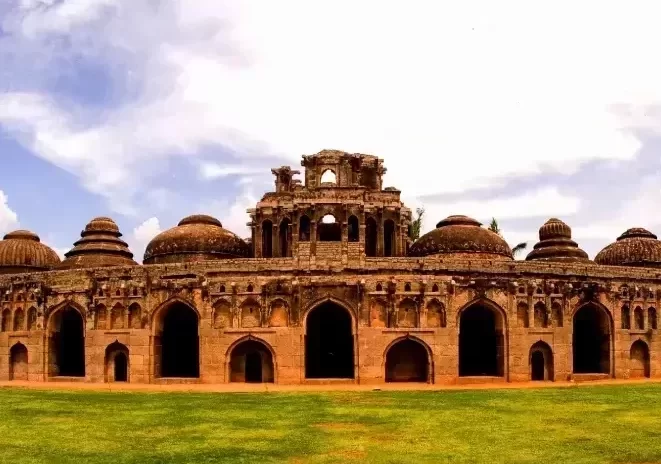Hampi
 Hampi, once the fortified capital of the Vijayanagara empire in the 14th century, thrived as a bustling metropolis by 1500 CE, rivaled in size only by Beijing. Traders from Persia to Portugal frequented its markets, attesting to its prosperity. Chronicled by Persian and European travelers, particularly the Portuguese, Hampi stood proudly on the banks of the Tungabhadra River, adorned with temples, farms, and bustling trade hubs.
Hampi, once the fortified capital of the Vijayanagara empire in the 14th century, thrived as a bustling metropolis by 1500 CE, rivaled in size only by Beijing. Traders from Persia to Portugal frequented its markets, attesting to its prosperity. Chronicled by Persian and European travelers, particularly the Portuguese, Hampi stood proudly on the banks of the Tungabhadra River, adorned with temples, farms, and bustling trade hubs.
Between 1336 and 1570 AD, from the reign of Harihara-I to Sadasiva Raya, the monuments of Vijayanagara were erected, showcasing magnificent Dravidian architecture. Krishnadevaraya’s contributions from 1509 to 1530 AD further embellished the city with royal edifices. However, in 1565, Hampi fell to Muslim sultanates, bringing about its downfall. Despite pillaging and ruin, Hampi’s enchanting natural landscape, framed by the Tungabhadra River and unique boulder formations, endures to this day.
Places to visit in Hampi
Virupaksha Temple: Dedicated to Lord Shiva, this ancient temple is one of the oldest functioning temples in India and a significant pilgrimage site.
Vijaya Vittala Temple: Known for its iconic stone chariot and musical pillars, this temple is a masterpiece of Vijayanagara architecture.
Hampi Bazaar and Monolith Bull: Explore the lively market street of Hampi Bazaar and admire the monolithic Nandi (bull) statue nearby.
Elephant Stables: Marvel at the well-preserved elephant stables, a unique blend of Indo-Islamic architecture.
Lotus Mahal: Visit this elegant structure with its distinctively shaped domes and intricate carvings, believed to have served as a royal palace or a pavilion.
Hazara Rama Temple: Admire the intricate bas-reliefs depicting scenes from the Ramayana at this temple dedicated to Lord Rama.
Queen’s Bath: Explore the elaborate bathing complex built for the royal women, featuring a sunken bath surrounded by ornate balconies and arched corridors.
Matanga Hill: Hike up Matanga Hill for panoramic views of the Hampi landscape, especially breathtaking during sunrise or sunset.
Achyutaraya Temple: Discover the ruins of this temple complex, known for its impressive architecture and intricate carvings.
Sanapur Lake: Relax by the tranquil waters of Sanapur Lake, perfect for a leisurely boat ride or a picnic amidst nature.
